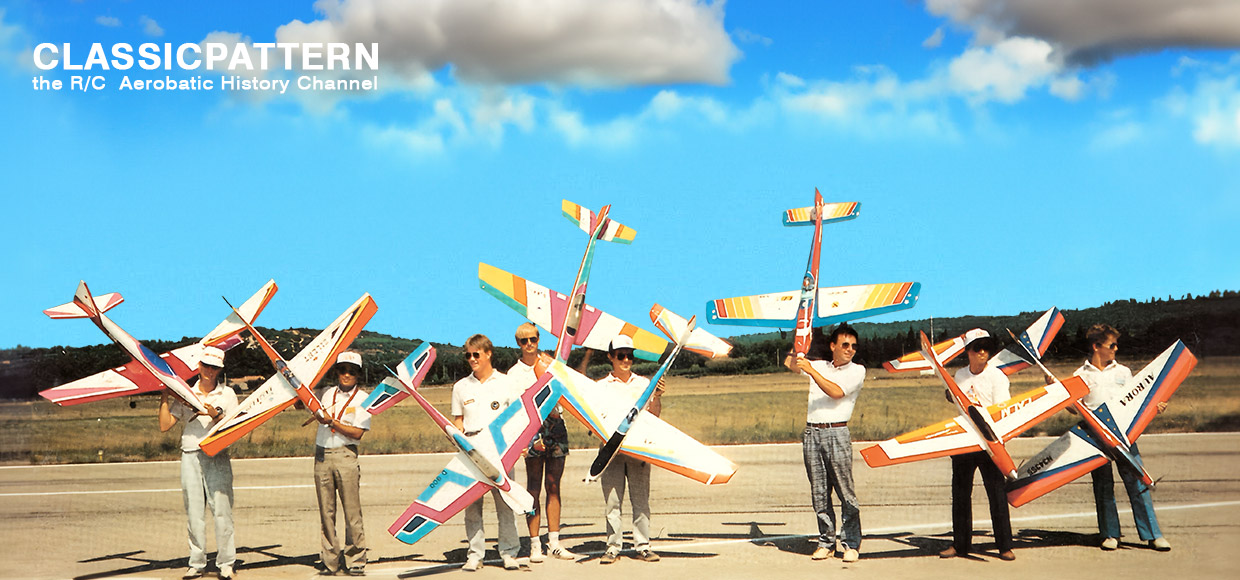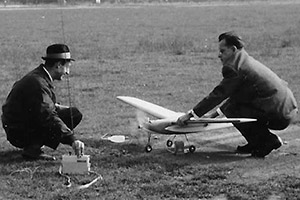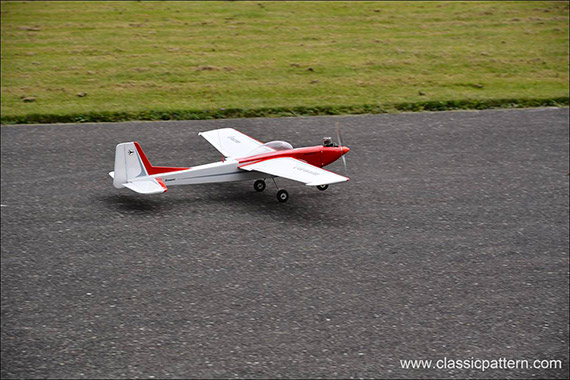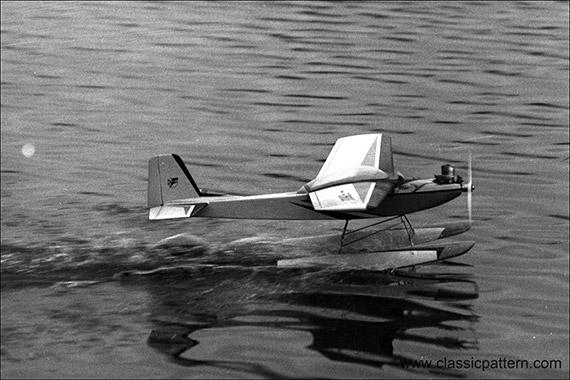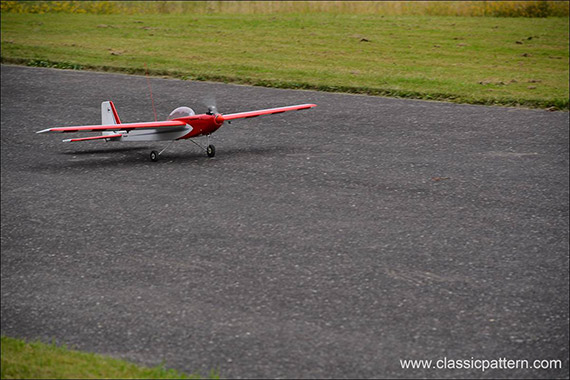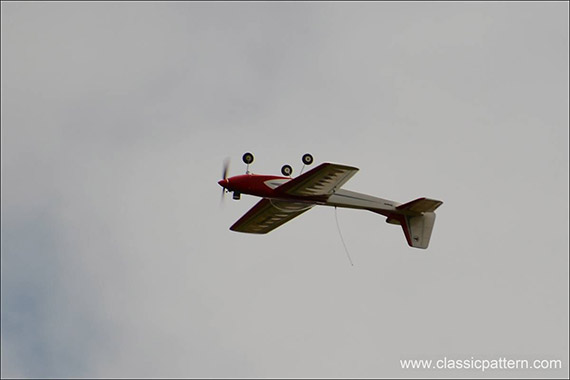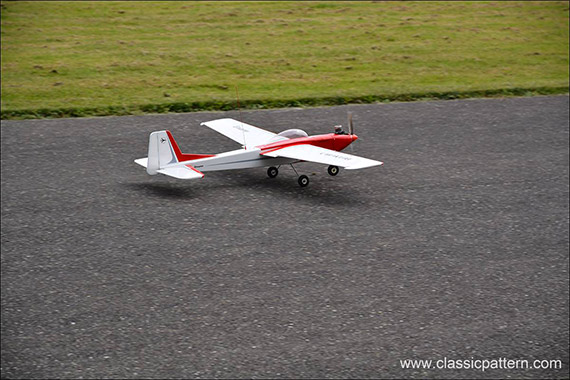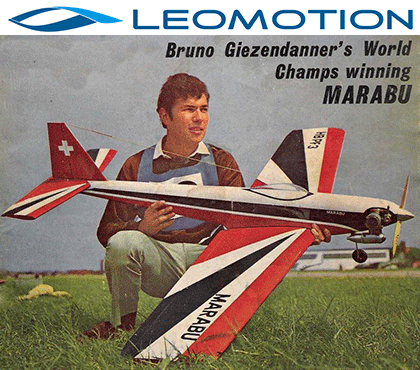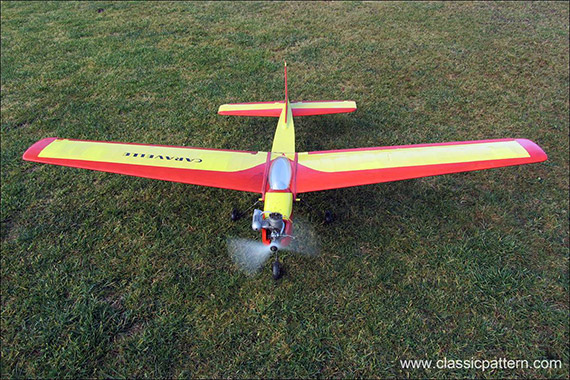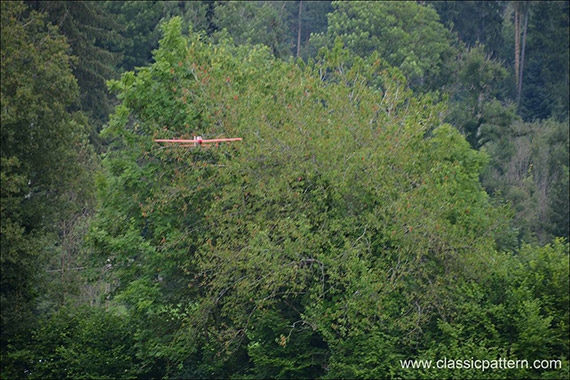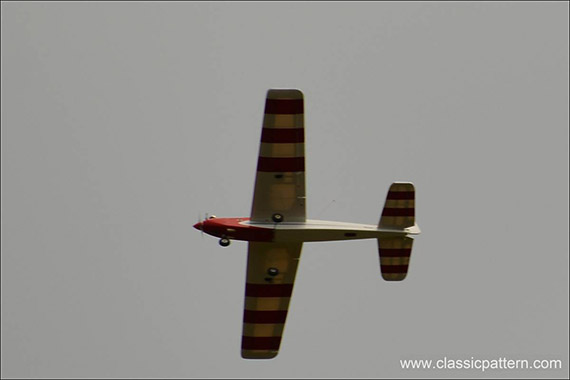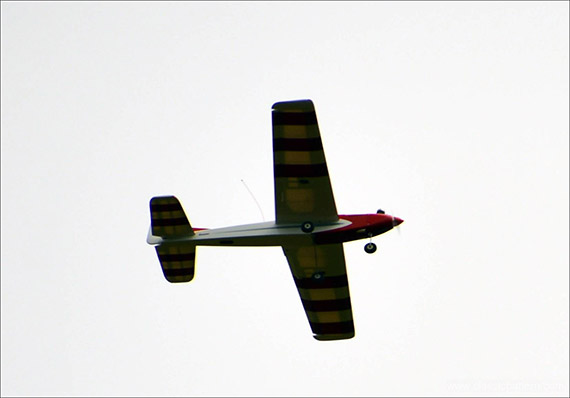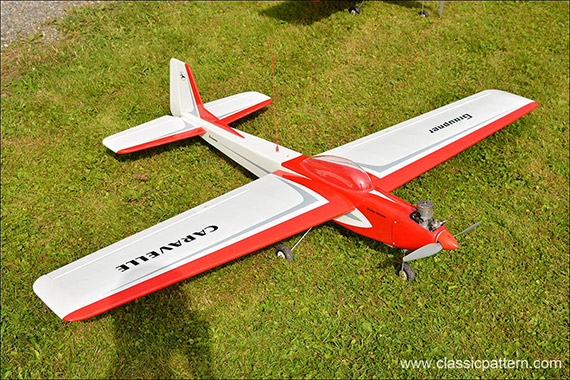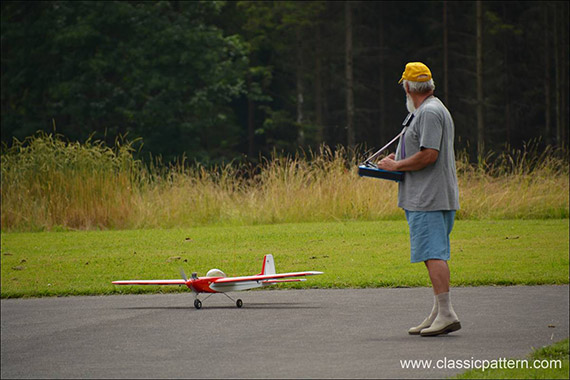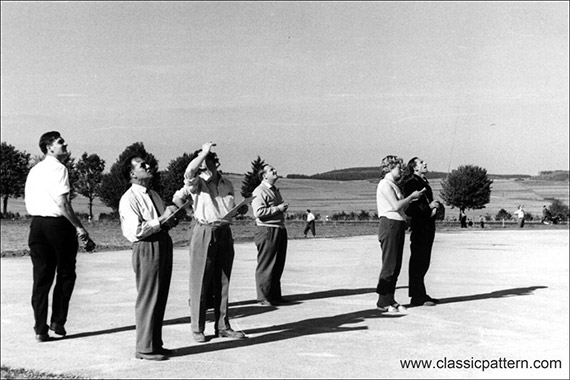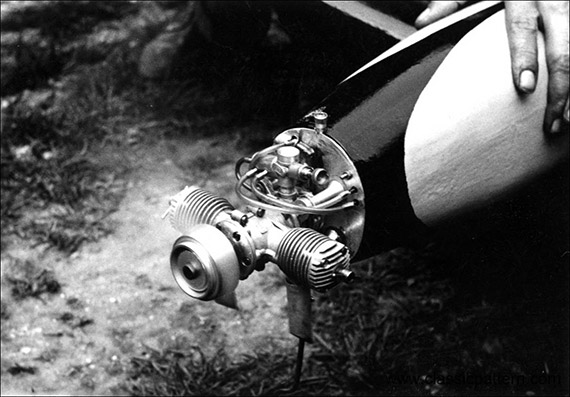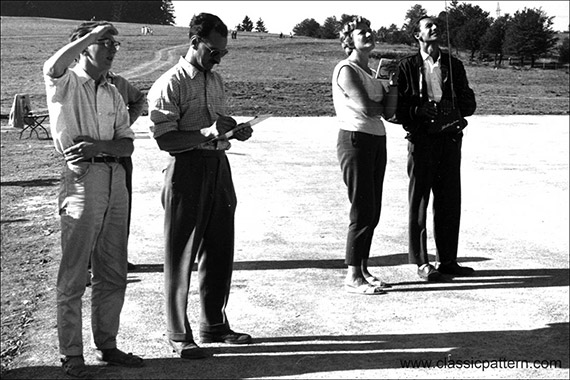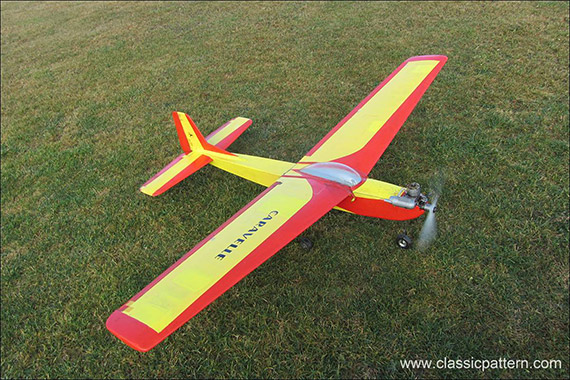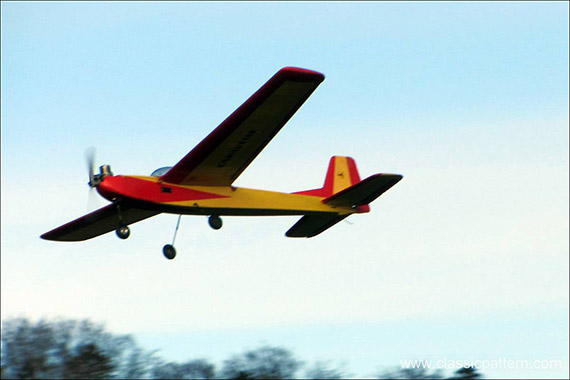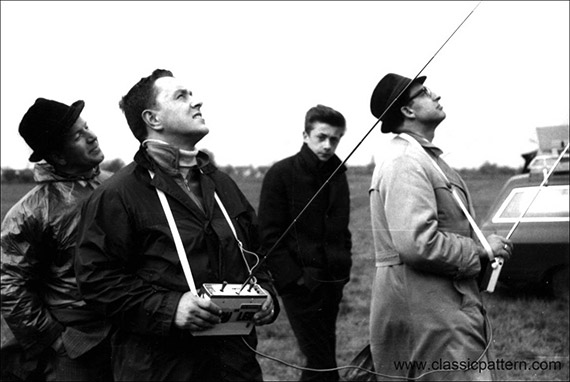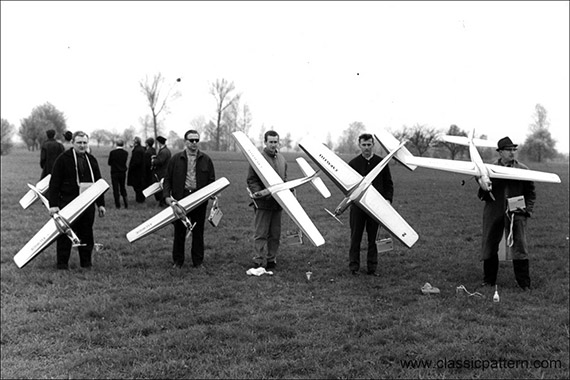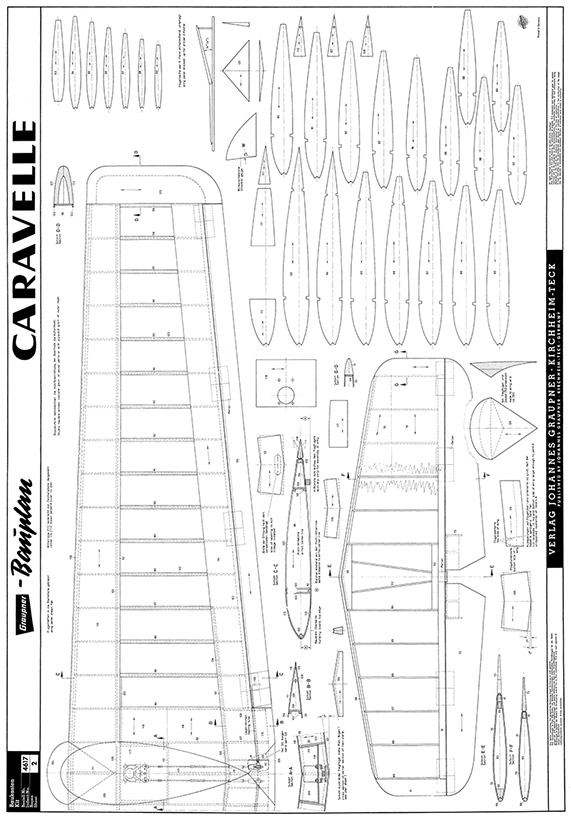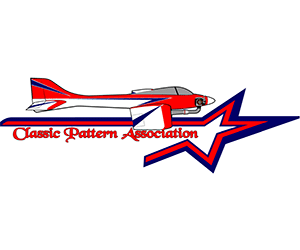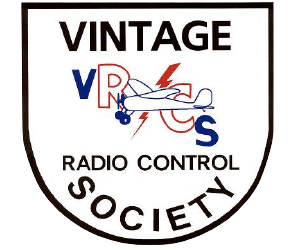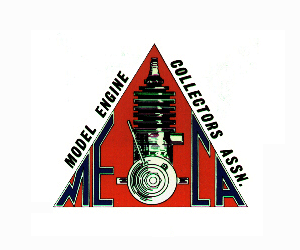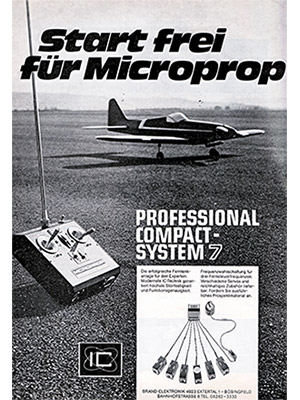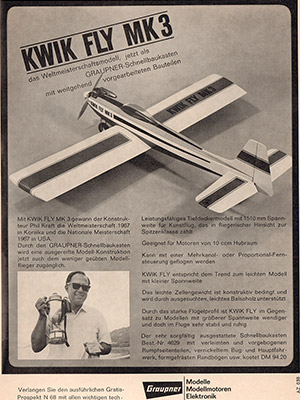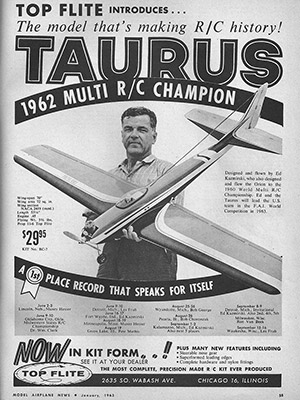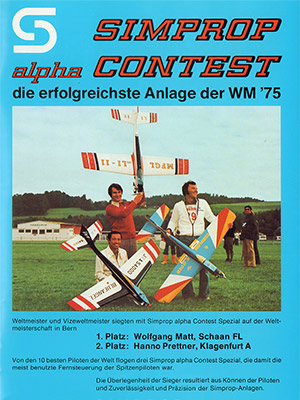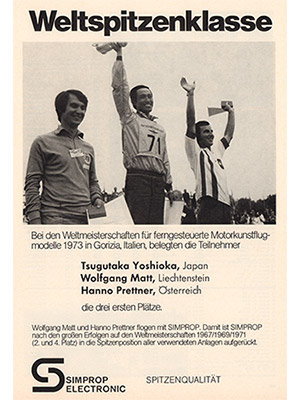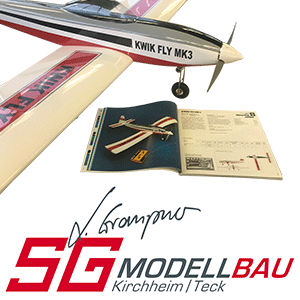Today, we present photos from the Graupner family archive for the very first time. We would like to thank the Graupner family for supporting us in our future research into the history of model aircraft. First of all we publish a test of the legendary Graupner Caravelle by the author Dieter Heck.
Thank`s to Martyn Kinder for language support!
In the autumn of 1962 Dieter Heck received a call from the Graupner company that we should quickly come to a meadow near Kirchheim (Teck), where we would see something very special. When we got there, the first thing we saw was Gustav Sämann in a black silk shirt, looking from a distance like Giacomo Casanova, along with some other gentlemen, all of whom were staring intently into the air. So an R/C “barge” had to be up there. We also stared: the “barge” was doing loops and rolls, Immelmann’s and Cuban Eight`s, as is the case when Gustav Sämann is on the ground and a multi-channel model in the air.
Everyone is alone with his fear …
And then it happened that fear went into my bones: no, not what you think! But Sämann suddenly pressed the transmitter into my hand and said, “Well, now, you fly!” and then took three more steps back, so that I had no choice but to hold on to the box. As the cautious person that my mother brought me up to be, I first did what is dishonourable according to the Prussian officer’s code, but still the most sensible thing to do in an obvious, dangerous situation: namely, do nothing at all. And the model flew on! With what I knew about fast multi-channel models up to that point, I found that amazing.
Breathed a little more freely again.
“And now fly a curve!” I stared at the transmitter, which suddenly seemed incredibly complicated with its two sticks, each of which can be set to 4 different positions, giving a total of 16 different possibilities, 15 of which are usually wrong.
“There with the thumb on the right, aileron, like this … but look at the model … that’s enough”.
The devil’s “barge” was already hanging steeply in the curve, turned round and round, flattened out more and more and came out again nice and slowly. “You see, you can correct that now with very light tips if you want to go further around.”
“Aha!”, I tried.
I breathed more freely again.
“And now the same on the left!” It worked, there was a very good turn, nothing interesting happened at all, and that was the most interesting thing.
“So, now fly a loop!” ordered Sämann.
“How?” I asked very stupidly.
“By pulling the elevator!” said Sämann. I pulled the same, and sure enough, the “barge” went. It didn’t get stuck at the top, it didn’t fall out, it came back down nicely, just like on the Ferris wheel or the roller coaster. The thing was very amazing.
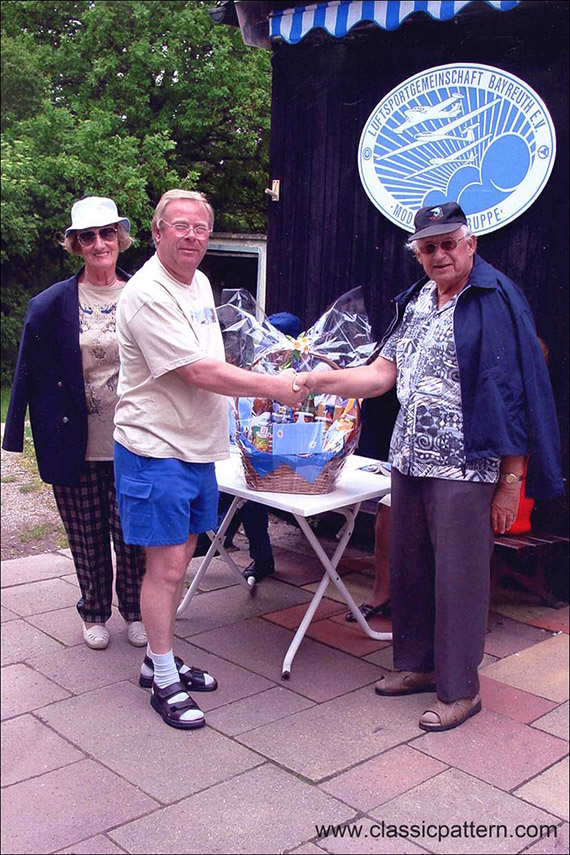
Well, once you’ve got that far, it doesn’t take much guts to push the aileron, for example, until the “barge” has turned all the way around, which is called a roll. It wasn’t a nice one, but at least it was a roll from the tail. But don’t think I was proud of it, I still felt queasy! I get terribly annoyed when I throw my own models down, and I don’t know how I would feel if I broke other people’s models. I haven’t tried that yet. Anyway, things went on like that for a few minutes. I had already got used to the thing flying.

“But does it land?” I finally asked. Then Gustav was so gracious and took the audio frequency box again and announced: “Now you will hear something very special”. Again …
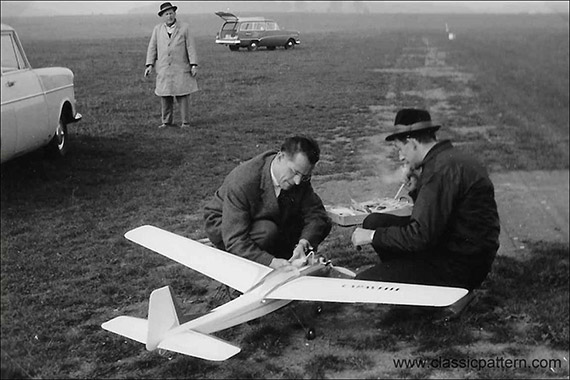
Graupner had his mobile model clinic on the lawn for this test, in which there is a listening receiver with a loudspeaker so that you can hear the transmitted sound signals. We had already got used to which tones meant which control. Sämann made a nice landing approach and took off against the wind, but much too high – “He’ll never get in!” I said, because from the experience of others I thought I could judge that. But Sämann throttled back, waited a few seconds and then pulled the elevator. It made a noise – and didn’t stop. Here it comes! I thought, if he continues like this for another three seconds.
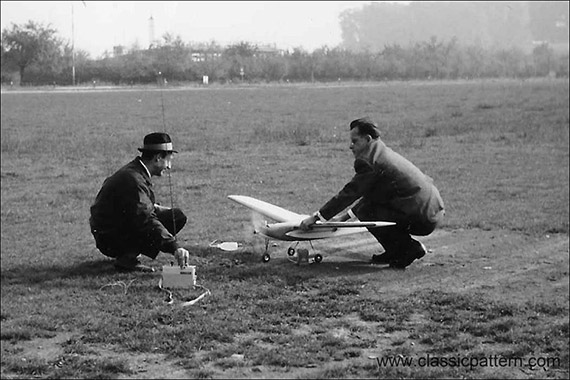
All right, once you’ve got that far, you don’t have to … even if it is stupid.
But again, the stall did not come. The “barge” kept perfectly healthy in the air with the elevator pulled and the engine throttled back, clung somewhat wearily to the wings in a kind of bashful stall – and remained controllable! It still responded to rudder and aileron and settled into a steep but slow landing approach. Iron Gustav put his foot down on the elevator – the control signals were given simultaneously – until a few metres above the ground, then turned everything off and let the box hop over the grass. This was Heck’s first and only so-called “aerobatic flight”, and anyone who knows anything about model aerobatics will admit that it was somewhat unusual.
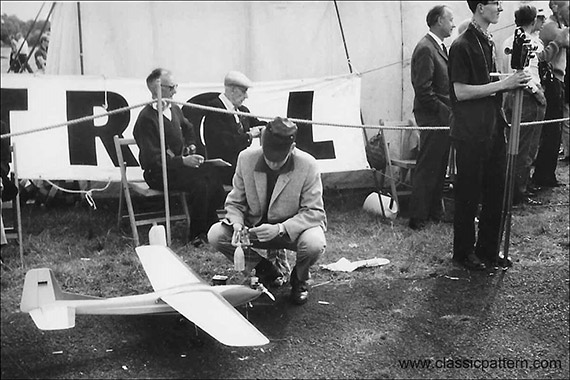
On that day, the models were flown until the adoring public’s feet and fingers grew cold. Sämann let the model with a wingspan of 1.8 m and an 8.1 cc engine simply hobble off to take off from the short, eaten grass of the sheep pasture. It would be too much to say that the model went straight as a die, but it didn’t make the slightest sign of a hop, it took off after twenty metres, and Gustav then pulled it up at a steep angle.
As expected, the take-off photos didn’t turn out to be much, and a model in the air is nothing to record anyway. On request, Sämann flew some close approaches, including inverted, and the machine, like all modern multi-channel models, was so fast that you had to pan the camera along as you would in a motorbike race.
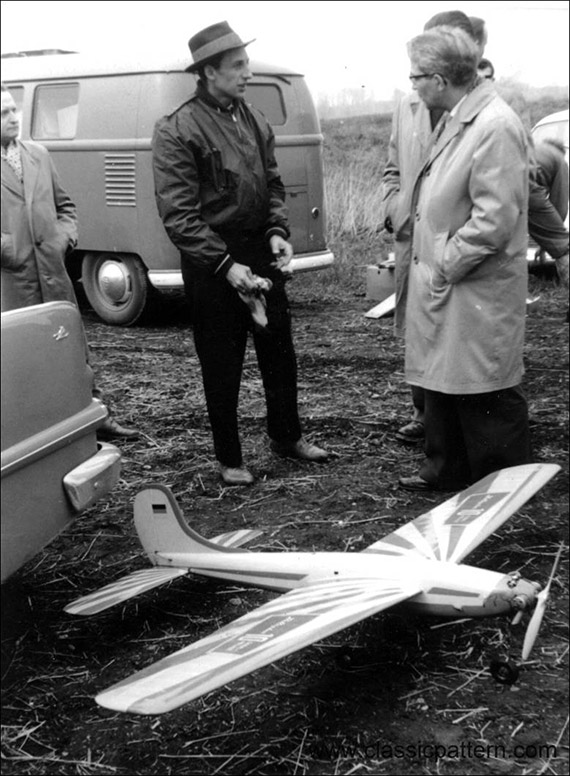
It was estimated to be flying at 100 km/h, but nobody knows exactly, because it was not stopped. It is also not important, because the model moved very stiffly through all the figures, hardly reacted to different kinds of flying speeds and that is the main thing.
The rehearsal fool
Of course, the Graupner guys had something very special in mind when they invited us. They wanted to show, to put it bluntly, ”non-experts by profession”, that this machine, called the “CARAVELLE”, is indeed foolproof to fly, or at least, relatively foolproof. And to prove the point, they chose me! If it now says here that of all the multi-channel models that have flown over our heads so far, that this is actually the easiest and least critical to control, then this is a statement made by us and not by Graupner.

The model was Graupner’s so-called “hit” for the 1962 Nuremberg Toy Fair. That is normally of little interest to us. But after what we had seen, it was also a game changer for RC flight and would most certainly help to familiarise even more people with fast controlled flight. If we had constantly written, since 1960, when the Americans first showed us the fast low-wing monoplane in Zurich, that multi-channel flight was primarily a matter of skill and that it must be approached with caution, then this was true after all the experience gained since then.
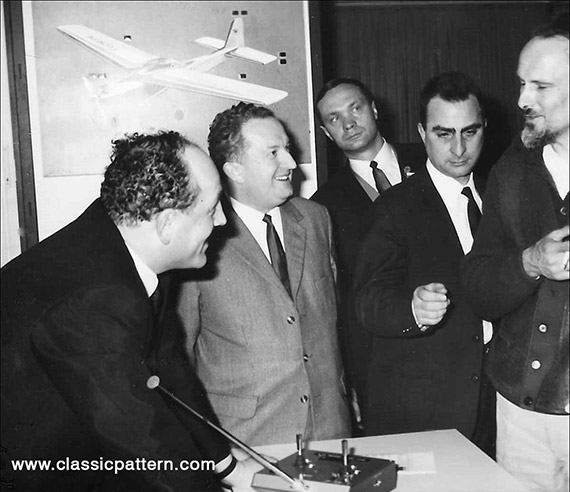
Sämann had already made an effort with the “Feuervogel” distributed by Webra, Berlin, to create an intermediate, a trainer for multi-channel flight. From what is known today, it was probably too small (the Feuervogel, not the Sämann). Nevertheless, it was a necessary link within the overall development of the “ZEUS”, a multi-channel trainer distributed by Robbe, which had now also come out as a novel design and was developed by Heese. This model also belongs to the category of the tamed, but one which can nevertheless be trimmed for the very sharpest use.
That latter statement is also true, at least with regard to the Caravelle which had already been proven insofar as this model is not “new” in the actual sense. It had already been illustrated in many modelling magazines all over the world, including “Modell”, of course, because it was nothing other than the same machine with which Sämann flew to 8th place at the 1962 World Championships in Kenley. That 8th place however, – and this should be said for those who tend to rate placings in such competitions too highly – was demonstrably not due to the model, for our colleague Ginn wrote at the time: “It was a pleasure to watch Gustav’s slim, fluidly flying model. He had every chance of being rewarded for his disappointment in the first flight; but now, for the fourth time in six flights, a dying engine ruined his chances.
“The model had not been significantly changed from the long-distance championship model. Aerodynamically, everything remained the same as it was then. Only in the detail of the actual construction had some “internal” changes to the kit which were based on construction experience, made in order to simplify the construction and also to enable re-trimming from a very tame two or three-channel controlled trainer to a fast eight-channel aerobatic acrobat.
The model is a high or shoulder wing aircraft with a one piece 180 cm span wings a stable box fuselage, which does not look particularly “racy”, and a high tripod landing gear. In the Kenley, Gustav flew almost without any dihedral but in the kit model, the dihedral can be selected according to the desired aerobatic characteristics, i.e. according to the pilot’s skill.
Safety in the wingtips
The special flight characteristics that we have described are, of course, due to the model construction. They are primarily due to a selected side surface distribution and the choice of aerofoil. In earlier years Gustav Sämann became known in model flying circles as a Wakefield specialist, he was the 1955 world champion in this class. For years, however, he has been working on multi-channel motor models and he has done this just as thoroughly as he used to do with rubber-powered models.
In the final refinement of a design, many things that are related to intuition and practical experience naturally play a role that cannot be directly quantified. Nevertheless, Sämann has deliberately followed a certain path, especially in the construction of the wing, namely that of aerodynamic skewing, and it can be said very precisely where the special flight characteristics come from.
It should not be unknown what a twisting is: a twisted wing is twisted in itself; the chord at the root has a different angle to the longitudinal axis or direction of flow than at the wing tips, so that the wing is more steeply inclined on the inside than on the outside. This results in the surface exhibiting particularly favourable breakaway characteristics.
The greater the angle of attack, the more the airflow breaks off at a certain part of the profile. In the case of a wing that is set in itself, the airflow therefore breaks off first towards the root, while it continues to flow at the wing tips with their lower angle of attack. Therefore, there is no complete stall at all, which means that the flying machine does not tend to stall directly: if it stalls, from a certain lower speed onwards part of the wing drops out, the lift decreases, and the leading edge moves downwards. Instead of a hard “kink”, the model stalls gently and flatly and picks up speed again.
See the Caravelle! At the top of the loops, of course, the Caravelle also slows down, but it does not fall out sideways, even when steered by a guy like Heck, precisely because the outer parts of the wing have lift even when actually “stalled” (at the top point of the inner loop it should of course be called downforce) and lateral stability is maintained.
A form of wing limitation known since the First World War is, for example, the Zenonia wing, named after the Zenonia seed, which has a “wing” with which it can cover long distances when it falls from the tree. In the Zenonia wing, the rear part is raised at the end of the wing, which results in extremely docile flight characteristics. However, the raised trailing edge brings a higher air resistance.
A “set” without twisting in the wing and practically without increased drag is the so-called aerodynamic set. The joke here is that the wing has a profile with a higher lift coefficient at the root than at the wing tips, e.g. a Clark-Y profile on the inside, which merges into a symmetrical profile at the wing tip.
The Clark-Y still has “hard” stall properties, i.e. at a certain angle of attack, about 12-15°, the flow on the upper side suddenly breaks off completely and the lift drops into the basement. With a symmetrical aerofoil, however, it is different; if the angle of attack becomes too large, its lift also decreases, but not abruptly, but gently and slowly.
A surface that has a Clark-Y profile at the root and a symmetrical profile at the ends of the surface thus exhibits practically the same properties as a skewed surface: the flow breaks off first on the inside, while it is still present for a long time at the ends of the surface and keeps the machine stable.
As already mentioned, it is important that lift does not fail to occur at the wingtips, because even small changes in the lift value would cause relatively large movements around the longitudinal axis, whereas changes in lift at the wing root are effective much closer to the centre of gravity and therefore cannot generate a large torque, even if the flow breaks off unevenly there, i.e. further on one side than on the other.
With such a design, critical flight positions that would lead to smearing or breakaway do not or no longer suddenly occur. The wingtips are “held”.
By the way, this is also the reason why all-wing (tailless) gliders that have a continuous wing set are particularly stable in lateral flight, although they also have the stabilising effect of a strong arrow shape. However, an aerodynamic cross-section, an even transition of the aerofoil shape from rib to rib, is also less difficult to produce than a “twisted” surface, especially if the rib shapes are already predefined, as in a construction kit.
It is, as I said, important that just at the wingtips the lift is V-shape according to skill. In Kenley, Sämann flew with an extremely low dihedral, as the shot here also shows, almost with a “flat” panel as the wing. This, too, was certainly only made possible to a large extent by the wing restriction. However, a small dihedral and especially symmetrical aerofoils, which have no “top” and “bottom”, improve the inverted flight characteristics. So you can see how different advantageous characteristics were combined in the design and complement each other.
In the kit model, however, a V-position of the wings of 7° dihedral is provided, because one wanted to have tame flight characteristics. However, “tame” is meant relatively here, because the aircraft that flew during the demonstration was already one of the kit prototypes with which extremely interesting aerobatics were also performed. With this dihedral angle and a wing-to-tailplane angle difference (decalage) of 1.5-2° as well as a very slight top-heavy trim, the Caravelle can easily be sent on tours with 2 or 4 channels and is then a very well-behaved and tamed thoroughbred horse that is considerate to its rider.
We have seen for ourselves that this is possible and not just as an advertising argument, because the fully equipped machine was flown for a while with only two channels. For this tamest setting, a 3.5 cc Taifun Bison is perfectly sufficient for the aforementioned angle of attack difference, it is even sufficient for simple aerobatic manoeuvres. You do not want to have a rapid climb at all in this setting, because if you have not yet completely mastered a multi-channel model, it is not very pleasant if the model shoots upwards like a rocket.
For extended use with increased practice, however, two other settings have been precisely defined, namely either for “multi-channel flight for beginners” and “multi-channel flight for experts”, whereby it is of course up to everyone whether they feel they are an expert. Of course, the best thing to do with the Caravelle is to try it out carefully first to see if there is any justification for it, because, as we know, there are more “experts” than experts. For the other settings, an 8.16 cc engine (Graupner of course calls its 0S-Max 49 RC, but of course any other engine of comparable power is just as usable) is provided, with a smaller setting angle and a centre of gravity that is further back.
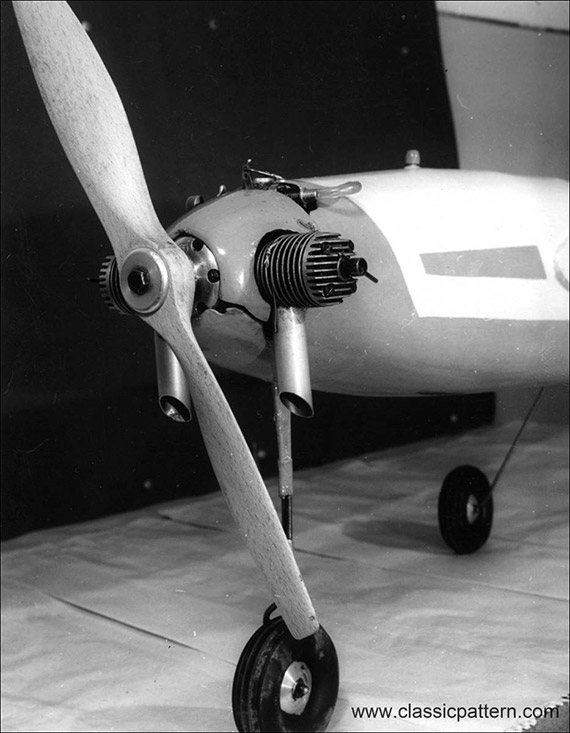
Sharpened
Finally, the engine comes with 0 degrees of down thrust and 0 degrees of side thrust built into the fuselage nose, the dihedral is reduced to 2% and the decalage angle difference down to 0 degrees. This is then something for people of the calibre of Sämann himself. The attached table advises about the individual data of the different adjustments.
Just like the Kenley model, the wing has a NACA 2415 profile I do not know how many machines were built before the Kenley specimen became the final kit design – I heard there were 6. In the course of this development, however, various details were changed, all of which we have been informed in detail. It is very important that the ailerons were finally designed as a continuous movable strip. The control action of these extremely long ailerons is the same as that of the rudder, but they bring many advantages in terms of construction.
There is no need for the construction of the inset on the wing and the rudder is only a narrow strip, which is easy to manufacture. But then the amount of rudder levers, push rods, etc. is considerably less. From the servo in the centre of the one piece wing, only a short push rod, for the most part outside the wing, leads to the trailing edge without deflection to a lever on the axis of the aileron end bar.
Any mechanism in the finished wing that is no longer accessible is eliminated. Ailerons designed as a continuous movable strips are becoming more and more popular anyway, precisely because of the simpler construction. Just like the Kenley model, the wing has a NACA 2415 modified profile, i.e. with a slightly downward curved underside at the root, which merges into a symmetrical profile at the wingtip.
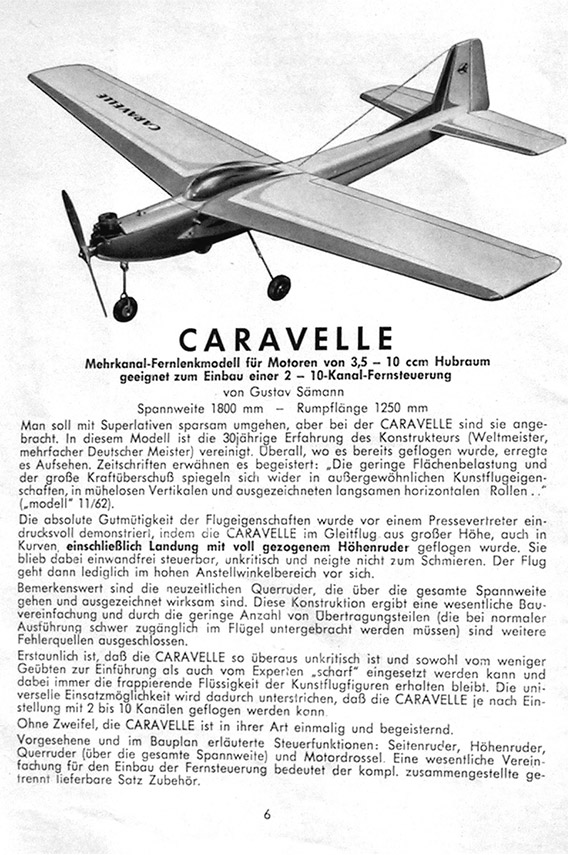
According to the new construction method, only the wing has to be built up as a continuous trapezoid, to which the aileron end strips are then attached.
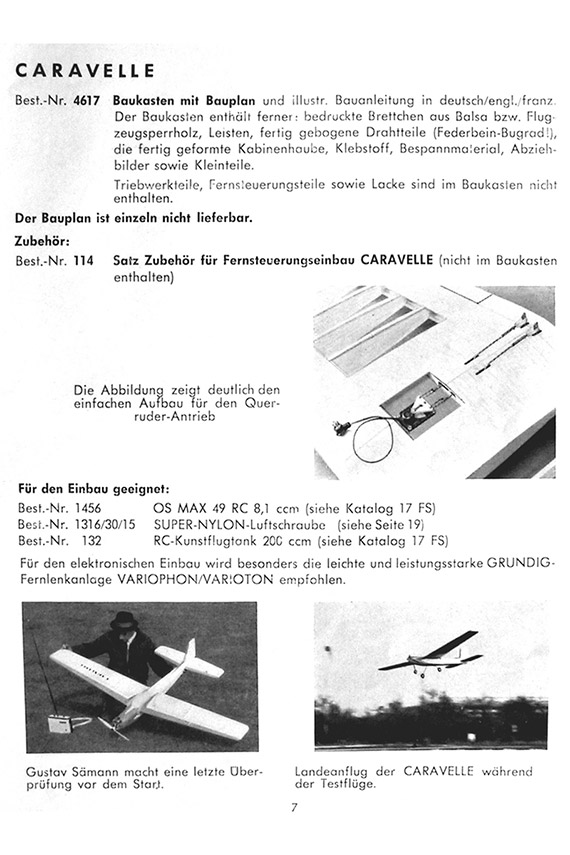
Furthermore, a lot of effort has been spent on the construction of the nose wheel leg, which was still bent on every landing. Now a strut is used which consists of two coiled strong steel wires and which springs backwards when landing and does not bend any more. It is suspended from a special frame.
During the engine tests, the Caravelle was flown at 3000 g (more than normally necessary for a model not intended for aerobatics) with the 3.5 Typhoon Bison. It had an absolutely satisfactory rate of climb. The fact that the model is much easier and less critical to fly with this relatively weak engine than with a real powerhouse in the front does not need to be emphasised, even though in our opinion it will be hard to avoid that many people will still hang large engines on it because of the “good sound” and then may get into trouble with it.
The setting angle differential pendulum
With fast models it is understandably very important to have an exact setting angle difference between the wing and the tailplane, because with a strong inflow even a slight setting error has a much stronger effect than with a slow model. However, in the case of aerofoils with a cambered underside, the EWD is not as easy to determine as, for example, in the case of a Clark-Y. Therefore, a so-called “setting angle differential pendulum” has been developed, with the help of which the EWD can be precisely checked.
Basically, this pendulum is nothing more than a hollow form which fits exactly under the underside of the wing, is fastened underneath it with rubber and from which hangs a string with a small weight which runs over a scale calibrated in degrees of angle. A similar pendulum is strapped under the tailplane at the root. The difference in the angular degrees read off the two scales is then equal to the difference in the setting angle.
It might be worth spending two or even three hours at home to check such an adjustment before launching a multi-channel model. If you really do this with care, you have an absolute guarantee that you can then put the model on the ground in the field and take off without having to reckon with any special surprises. Hand launching is also difficult with the Caravelle. The procedure with the setting angle difference pendulum balance has been thoroughly tested on various models by Sämann itself and at Graupner. Models trimmed in this way were then launched directly for aerobatics without further preliminary tests.
The Caravelle is a very special model whose design will certainly have an influence on the overall development of fast multi-channel models. For us, as a model magazine, it is of course not important that as many kits as possible are sold, but that such models exist at all and are available to many. Nevertheless, the Caravelle should not become a model that – please excuse me, dear reader – only Hinz and Kunz want to fly, whereby I count myself among the Kunzen – but by model pilots who are serious about the matter and who know how to use the characteristics of such a design.
I believe that both Sämann, who two years ago was very reluctant to announce multi-channel designs because he didn’t want inexperienced pilots to suffer shipwreck with them, and the Graupner people think the same. They have decided not to include die cut parts in the box, but only to print the shapes, so that the accuracy of the construction is no longer determined by the accuracy of a master machine, but by that of the modeller. It is therefore entirely up to him to what extent he really exploits the constructive possibilities.
Specifications:
Wingspan: 1,80 Meter
Length: 1,23 Meter
Weight: 2500 Gramm
Powerplant: 10cc Nitro engine, electric drive
Text: Dieter Heck
Images: Burkhard Erdlenbruch, Peter Uhlig, Gustav Sämann, Jörg Stümpflen, Hans Graupner
